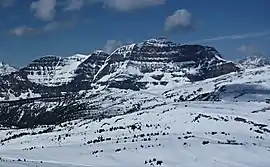The Monarch (Canadian Rockies)
The Monarch is a 2,895-metre (9,498-foot) mountain summit located in the Ball Range of the Canadian Rockies in British Columbia, Canada. The Monarch is situated on the boundary between Kootenay National Park and Mount Assiniboine Provincial Park, four kilometres to the west side of the Continental Divide. Although not visible from roads, The Monarch is a prominent feature seen from the slopes above Sunshine Village ski resort. Its nearest higher peak is Mount Bourgeau, 10.35 km (6.43 mi) to the north-northeast.[1]
| The Monarch | |
|---|---|
 The Monarch | |
| Highest point | |
| Elevation | 2,895 m (9,498 ft) [1] |
| Prominence | 555 m (1,821 ft) [2] |
| Parent peak | Mount Brett (2984 m)[2] |
| Listing | Mountains of British Columbia |
| Coordinates | 51°03′05″N 115°50′54″W [3] |
| Geography | |
 The Monarch Location of The Monarch in British Columbia  The Monarch The Monarch (Canada) | |
| Location | British Columbia, Canada |
| Parent range | Ball Range,[1] Canadian Rockies |
| Topo map | NTS 82.O.04[3] |
| Geology | |
| Age of rock | Cambrian |
| Type of rock | sedimentary rock |
| Climbing | |
| First ascent | 1913 Conrad Kain with Interprovincial Boundary Survey[2] |
| Easiest route | Scrambling |

History
The first ascent of the mountain was made in 1913 by Conrad Kain with Interprovincial Boundary Survey.[2] In a report by the Interprovincial Boundary Survey, the mountain is referred to as Monarch Mountain, a fine piece of mountain architecture dominating the Simpson Pass area.[4]
The mountain's name became official in 1924 when approved by the Geographical Names Board of Canada.[3]
Geology
The Monarch is composed of sedimentary rock laid down during the Precambrian to Jurassic periods.[5] Formed in shallow seas, this sedimentary rock was pushed east and over the top of younger rock during the Laramide orogeny.[6]
Climate
Based on the Köppen climate classification, the mountain is located in a subarctic climate zone with cold, snowy winters, and mild summers.[7] Temperatures can drop below −20 °C with wind chill factors below −30 °C. Precipitation runoff from The Monarch drains into tributaries of the Simpson River, which is a tributary of the Vermilion River.
References
- "The Monarch, British Columbia". Peakbagger.com. Retrieved 2019-11-10.
- "The Monarch". Bivouac.com. Retrieved 2018-12-05.
- "The Monarch". Geographical Names Data Base. Natural Resources Canada. Retrieved 2018-12-05.
- "The Monarch". PeakFinder.com. Retrieved 2019-11-10.
- Belyea, Helen R. (1960). The Story of the Mountains in Banff National Park (PDF). parkscanadahistory.com (Report). Ottawa: Geological Survey of Canada. Archived (PDF) from the original on 2015-10-02. Retrieved 2019-09-13.
- Gadd, Ben (2008). Geology of the Rocky Mountains and Columbias.
- Peel, M. C.; Finlayson, B. L.; McMahon, T. A. (2007). "Updated world map of the Köppen−Geiger climate classification". Hydrol. Earth Syst. Sci. 11: 1633–1644. ISSN 1027-5606.